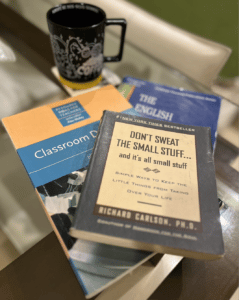Three books, three perspectives
In my early years of teaching, I hardly ever had someone to mentor me; I was pretty much left to my own devices, so I found some comfort in the books that I happened to come across. But some were more personally significant than others, and here is a roundup of three amazing books that have challenged my views on teaching and life. I hope they will challenge yours.
Classroom Dynamics (Jill Hadfield)
This is not simply an ESL resource book with warmers and fillers; rather, it is a brilliant book about learners working together as a group. Among many other sections, this book includes sections with activities to form a group, to highlight group strengths and individual contributions, as well as a section on group problems. I find this last bit extremely relevant, as most of us have already been faced with conflicts and “indigestible” groups, as Hadfield puts it. So, if you are looking for ways in which you can create and sustain a positive atmosphere in your classes by integrating fun-filled activities, this book is for you. And what’s more, it is a book that helps us to reflect on the human dimension of teaching and learning and the importance of collaboration among students.
The English Verb: An Exploration of Structure and Meaning (Michael Lewis)
“Is it possible to use the past simple with reference to the present?” “Is grammar difficult?” These and other questions had me completely hooked while I leafed through this book. Not because it was about teaching grammar. It was more than that: it linked structure and meaning from a fresh perspective that blew my mind back when I was working towards a DELTA certificate, and it still does. Lewis explores grammar by debunking some myths such as the concept of the English language as a mere set of accepted rules. Of course, I am not assuming we teachers see language as such, but how can we link meaning and grammar in our everyday teaching practice? Lewis’s book explanations and examples of how real-life grammar expresses meanings do not fall short of our expectations. For example, the section on “some” and “any” is a game changer as it invites us to rethink some of the rules we often see in course books. Although this is a book for teachers, I sometimes share some sections with my students, so that they too can begin to approach grammar, not as a set of illogical, frightening rules, but as a set of choices that speakers make in order to create meaning.
Don’t Sweat the Small Stuff… And It’s All Small Stuff (Richard Carlson, Ph.D.)
This is perhaps the most comforting self-help book I have ever laid my eyes on. Actually, it is the only self-help book that I have ever kept in my bookshelf. It is not exactly about teaching; it is about life and its little and big misfortunes and how we can cope with them. I usually share some chapters with my students, especially at the end of the semester. I ask them to read a random chapter and share its message with their peers. We may not agree with everything Carlson says, but surely the book as a whole will have us wondering why we waste so much time of our lives sweating the small stuff. So, why not rethink the way we deal with classroom problems?
kept in my bookshelf. It is not exactly about teaching; it is about life and its little and big misfortunes and how we can cope with them. I usually share some chapters with my students, especially at the end of the semester. I ask them to read a random chapter and share its message with their peers. We may not agree with everything Carlson says, but surely the book as a whole will have us wondering why we waste so much time of our lives sweating the small stuff. So, why not rethink the way we deal with classroom problems?

